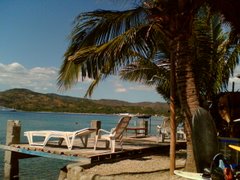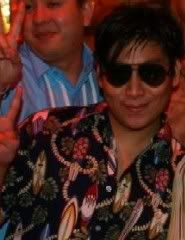see some pix in SoloflitesDementedWorld.blogspot.com
Vietville
For lunch, we dropped by the quaint little vietnamese community aptly
named "Vietville" for some er.. Vietnamese cuisine.
Vietville is one of the more popular tourist spots in the area. Originally it was a sort-of-refugee camp for boat people shortly after the Vietnam war broke out. At the height of the Vietnam war, the Philippines, along with a number of other nations pitched in for the boat-people and funded the creation of this village (all this I got from a commemorative signboard I read upon entering). Now it is now a thriving community of Vietnamese who chose to stay in Palawan even after they were given the opportunity to go back home.
Anyway, our group decided to have lunch at the famous Seafood restaurant there, and while the food was being prepared I decided to take a look around town.
It wasnt really a large village so I was able to walk around the area in around 20 minutes. Besides the Restaurant, there was only one major "sari-sari" store, one souvenir shop and some pens where they kept chickens, dogs and other animals. The houses here were definitely
different from the typical Filipino style in Puerto Princesa and I decided that it had to be, well, vietnamese.
Everyone I met was either biking or walking, all of whom would politely nod their heads and say "Mawning" whenever I got close. I was amazed at the number of first-generation vietnamese. I thought they'd be the first ones to return home once it was safe, but I guess Palawan just grew on them.
Near the edge of the village was a buddhist temple of sorts with a large pagoda with a statue of Buddha in his contemplative pose. Opposite to this however, was yet another pagoda styled almost like the first one.
Naturally, I was curious as to how a small community like this would have two buddhist temples and decided to take a closer look. This time, the statue doing the contemplation was none other than the Virgin Mary... Apparently that was their Catholic Parish! Talk about east meeting west!
I then went back to the restaurant and had an appetizing meal of spring rolls, shrimp and beef noodles and some of their famous French Toast (this was a bargain at 5 bucks each!) Afterwards, we prepared for the journey to the Underground River of Sabang.
The Road to Sabang
The trip going to the Underground River was an adventure in itself. The 2-hour drive going to Sabang can be done either by Jeepney, which will not leave until every bit of space has been occupied (including the rooftop and the "sabit" areas) or by a rented van.
The van, on hindsight, was a very good decision. Though more expensive, it made us able to enjoy the "Palawan Massage", what the local folks jokingly call the horribly bumpy 2-hour ride to Sabang. I, for the life of me, couldnt even begin to imagine how it would feel like to be taking this punishment of a ride on top of the Jeepney under the scorching noontime heat, hitting your flesh against the hard metal of the makeshift rooftop seats... but since it was a very comfortable air-conditioned van that we got, I just laid back and enjoyed the "massage".
The trip was otherwise uneventful, except for an occassionally great view of Palawans eastern coast or several limestone formations.
Sabang and the Underground River Nature Park
Sabang beach was our next destination. From there we could either hike 4 hours to the Underground River area or take a 20 minute boat trip. While I had no issues with walking for 4 hours with my pack, because of time constraints, we decided to go by boat.
The boat ride gave us an awesome view of the rock and limestone formations in the area as well as the surrounding beaches (see pix). The landing site was the Nature Park where the Underground River was located.
Back in Sabang beach, our van's driver who was also our tour guide for the day, advised us a couple of things before we disembarked for the boat. First, only bring stuff that are waterproof, and second, dont open your food in front of the monkeys.
The first one made perfect sense. The next didnt. And looking back, I should have taken it more seriously. In this little area gathered probably the only bayawaks (monitor lizards) in the Philippines who had no fear of being cooked adobo style and monkeys who could sneak up, snatch your potato chip bags, open it (Yes, i saw them do it!) and eat it in front of you.
When that happened, I saw the local guys flashing toothy grins and giving me the "Dont say we didnt warn you" look.
The Underground River
The Underground river is basically a large river valley that had one of the surrounding mountains collapse on it thousands of years ago. Through the years it was slowly eked out into a full-sized cavern with beautiful stalactite and stalagmite formations and developed into the longest underground river in Asia, reaching up to 8.5km from one end to another.
The opening from the nature park was a cave in the middle of a beautiful pool of clear blue water. To go inside, we had to go with one of the local boatmen and take one of the "Sagwans" or canoes which were retrofitted with high powered lights that could penetrate the darkness within the cave. Before that, we were asked to wear life jackets and miners hats. Again, the first one made sense, but the second one?
As I was thinking about this a group of dark flying creatures I mistook for bats swarmed towards the cave. The boatman used this moment to point out the use of the miners hats. There were two types of flying creatures which shared the cave- bats (active at night) and swallows (active by day.) Both of which could shit with impunity from above. I strapped on the hat immediately.
As we cast off from the park and started going into the cave, I decided to flash some light in the water. I peered underneath and saw little fishes that looked suspiciously like "Dulong"... which if caught alive and mixed with calamansi and onions, was a popular delicacy among island hoppers and local fisherfolk (and myself included). After making a mental note of bringing calamansi the next time I was in Palawan, and of documenting how typical it is of Filipinos to see and animal and try to remember how it should be cooked, my mind concentrated once again on the cave.
The "tour" that we were having covered only 1.5 km of the underground river. Beyond that, you need special permits from the Mayors office as the caverns would be too low for normal sagwans and professional diving gear would be required.
The first thing to notice once you're inside the underground river is the amount of movement. Inside these caves dwelled the swallows (which I earlier thought were bats) which were just flying all around the place. Our guide would later explain that this cave is one of the most popular spots for getting the swallow's nests, the main ingredient of "bird's nest" soup, but that the gatherers would have to scale at least 10 meters of sheer rock (and bat guano) to be able to get it.
And where were the bats? Sleeping apparently. As I shone my light through the caverns ceiling I saw rows upon rows of sleeping bats. I marveled at the timing of their internal clocks because try as I might, even my light couldnt wake them up. The guide explained they usually awaken all at once at around 5pm and return 5am the next morning at the same time again. I checked my watch- 3:30. I wouldnt see the show.
The cave narrowed and widened as we passed through. Our guide would occassionally point to weird stalactites they christened as "Ibong nakabaliktad", "mais", "Dinosaur" or some other descriptive names (which would require the same imagination as understanding how the different constellations got their names). Overall, going through the cave, I was just amazed at the sheer size of this underground cavern.
There were a few stalagmites in areas where the cave allowed for some dry land, but a lot of these just looked too creepy, and in the dim lights of the cave looked like an eery group of people discussing something. One looked so much like a human figure that other people who visited the area would later tell me they felt like they were being watched.
There was an area in the cave where there were a number of white painted crosses on the walls. Here, supposedly, the guide said, a number of priests tried to bless the cave years before. Why they blessed it, he didnt say. Which added to the creepy feeling the stalagmites gave.
My main frustration at this point was that it was so hard to take pictures. The lighting of the cave was just too dark, and simply snapping up pix required coordination with another person who would be holding the lights. Not to mention the fact that I was trying to keep the camera safe from falling bat guano.
The guide led us to an area he called "The highway". Here was a long stretch of smooth walls and stalactite-free cavern and was the most bat and swallow-free area. The walls were just beautiful, being dotted with thousands of little pockmarks that gave the effect of shining when the light flashes over them.
After the highway, encountered a larger cavern with plenty of stalactites hanging about. The guide then pointed to the dark recesses of the cave and told us that it was the end of our trip and to go further would require more sophisticated equipment. He then turned the boat around and led us on the journey back.
to be continued: Next: Puerto Princesa at night and Island hoppin in Honda Bay
Friday, May 20, 2005
Subscribe to:
Post Comments (Atom)


No comments:
Post a Comment